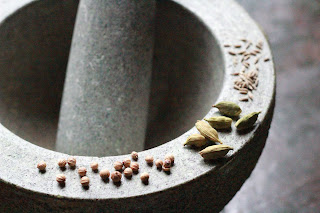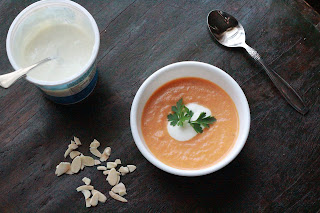Sometimes I really like a piece of perfectly crispy toast with orange marmalade. I'm not saying it's an all the time sort of thing, but sometimes it can be so good.
(No matter what, I always love toast. That part does not change.)
Often marmalades can be too bitter, most probably due to the white pith in the peel. I think you definitely need some bitterness, it's part of the orange marmalade charm, but it shouldn't be the sole and completely overwhelming part of the taste. In addition, I like when the peel has a little thickness- so that it adds a bit of substantial chewiness to the finished product. Not everyone wants their marmalade so textural. If you make your own marmalade you can cut the peel thin or thick, in long strips or as the diced bits you may desire.
Orange marmalade really doesn't require many ingredients. It's technically just fruit preserved in sugar.
The really nice thing is that oranges have all they need (besides the extra sugar) to thicken and become what we know as marmalade. The lemon is a little extra to brighten and enhance the flavor with a sour note.
Pectin is what makes jams and jellies jell along with a sugar and acid combination, and it's found naturally in citrus fruits- specifically the peels and pips.
Now, I think it's best to leave the seeds in so they can do their part to make the marmalade jell.
Really, it's ok if there are seeds in it. It may require a bit of deft maneuvering with a knife when it comes time for breakfast, but so be it.
Maybe you'll think the amount of sugar called for is horrific. Sorry, but this is the way it must be.
It seems that for a jam to jell as well as keep, you would need at least 50% of the fruit amount as sugar. It's a chemical reaction thing.
However, it's safer storage-wise and thicker with more sugar.
Ah, the magic of sugar.
And if toast is your vehicle to aid in consumption of your daily sugar ration, so be it.
That said, all I can say now is that there's no way anyone would eat all the jam in one sitting (even though it is an enticing jewel-toned shade of orange). You'll probably feel better in many ways if you share it.
Since I seem to amass vanilla beans (and keep what looks like a sad and gangly vanilla bean graveyard in a sugar jar), I took a suggestion from David Lebovitz and tucked a few of the used (but still flavorful) pieces of vanilla bean into a couple of the just-poured jars of jam. Those jars had a bit of a vanilla infusion with a delicate, slightly more complex flavor.
This jam isn't technically canned, so it should be refrigerated.
You're welcome to can it, of course, but I didn't feel like it was worth the trouble for the yield (especially if you're not eating it all yourself).
*Please use organic oranges and lemons since you're pretty much using the whole fruit.
Orange Marmalade
makes about 5 cups/1.25 l
3 large Navel oranges
2 lemons
Pinch of salt
Water
5 c sugar (1.22 kg)
Optional: vanilla bean (fresh or spent)
Wash the oranges and lemon with soap and water. Dry the fruit and set the lemon aside.
Peel the oranges, trying to keep the peel pieces relatively large
Place the orange peels in medium saucepan and cover with cold water. Bring to a boil, reduce the heat and simmer about 15 minutes. Remove the orange peels from the water to cool. Reserve the water.
Meanwhile, remove any strings and extra pith from the peeled oranges. Roughly chop the oranges and pour the orange bits and any juice into a large stainless steel pot. Zest and juice the lemons (along with the pits) directly into the pot and add the salt.
When the peels are cool enough to handle, remove some of the white pith using a knife, or by scraping it with a spoon. Chop the orange peels to desired thickness and add them to the pot along with the reserved water used to cook the peels. Add enough extra water to just cover the oranges and peel.
Bring the mixture to a boil, reduce heat, cover, and simmer 30 minutes. Remove the pan from the heat and let sit 30 minutes.
Add the sugar, stir, and and let the orange mixture sit an hour until the sugar dissolves.
Bring the mixture to a boil, reduce heat to very low and simmer about an hour and 30 minutes (for a thick marmalade). Stir occasionally to keep the marmalade from scorching on the bottom of the pan, especially after the first 60 minutes. Skim off and discard any foam that rises to the top closer to the end of the cooking time.
You can test a dollop of marmalade on a cold plate. If after it has a minute to cool on the plate it wrinkles when nudged with a finger, it's gelled.
Ladle the orange marmalade into jars, seal, and refrigerate. The marmalade will continue to thicken quite a bit as it cools.
(Note: Vanilla bean can be added along with the sugar, or if you have extra "used" vanilla beans sitting around, tuck a few pieces into each jar after you've poured the marmalade into them.)













































